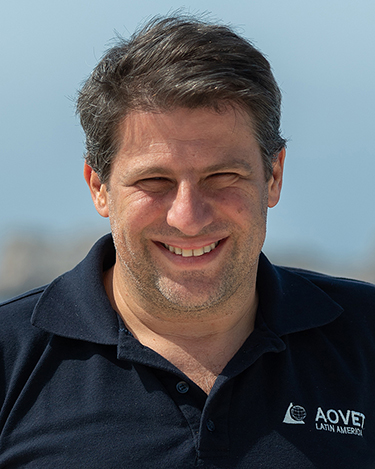Every picture tells a story
WITH CASSIO FERRIGNO

Cassio Ferrigno In his role at USP/FMVZ, Cassio is regularly called upon to treat service animals from across Brazil. In a break between events at the Davos Courses 2017, he discussed his most notable patient case and how his involvement with AO VET continues to shape his professional development.
“I am very attached to military dogs because I was in the army for two years [working with] dogs,” says Cassio, who earned his PhD in veterinary surgery from USP and did postdoctoral studies at the University of Florida. “The University of São Paulo treats all service dogs in Brazil pro bono, and one of the cases I have been most proud to treat involved a German shepherd police dog working with the São Paulo police.”
‘Help my dog recover’
Cassio proudly recounts a particularly complex case: After pursuing and cornering an armed man suspected of robbing a car, São Paulo police released their well-trained police dog to guard the suspect. Cornered and faced with a menacing canine, the suspect shot the dog four times—to no avail.
“With a very badly fractured humerus and punctured lungs, the dog actually disarmed the suspect,” Cassio says with amazement. “Policemen are very attached to their dogs—almost like family. This officer came to me saying, ‘Please, do whatever you can to help my dog recover.”
Very rewarding experience
Cassio and his team as USP/FMVZ did just that.
“The dog recovered pretty well, but its humerus was destroyed; his was a very comminuted fracture,” says Cassio. “We did three or four surgeries to help the dog use his leg again. He never returned to work, but the policeman took the dog into his home. It was a very rewarding experience.”
It’s not uncommon for São Paulo officers to send Cassio photos demonstrating their dogs’ on-the-job accomplishments.
“When a dog finds explosives or narcotics, they always send me photos and say, ‘Look what my dog did!’” he explains, pulling out his phone to show a photo of yet another patient. “I did a tibial plateau leveling osteotomy (TPLO) on this one. He went back to work.”
‘The best place’
In addition to his work at USP/FMVZ, Cassio also is AO VET Community Development Chairperson and an AO VET faculty member. He relishes the AO community spirit.
“Wherever we go as faculty, we learn something from the participants and from faculty involved in the courses. That’s very important to me,” he says. “I hope the AO can continue as a really global experience because it is good to have contact with peers around the world. We are doing almost the same cases, but someone can do something a little differently and help you a lot. The AO is the best place for networking and learning from one another.”
With contemporary technology, it’s easier than ever for veterinary surgeons to network—and that includes seeking advice from AO colleagues a world away by smartphone when prepping for surgery, he says.
“If I have a difficult case, with our networking, I can just FaceTime an AO colleague and ask, ‘What do you think?’”
Collaborating across clinical divisions
Cassio also appreciates ample opportunities within the AO to network with peers from other clinical divisions: AO Trauma, AO Spine and AO CMF.
“I did a Principles in Spine and an AO Trauma course as a participant, and last year I was invited to an AO Spine course as faculty because they were working with pigs and they needed an expert in the veterinary field,” says Cassio. “It was great because I do a lot of spine and trauma cases and I can actually learn from all of the different AO clinical divisions.”
A clear champion of all the AO has to offer, Cassio says he wants to see the AO continue expanding its network into less-developed areas.
“That’s the frontier we need to reach now. When you think about our mission of making a difference in patient care, that means going where we are needed,” he says.

